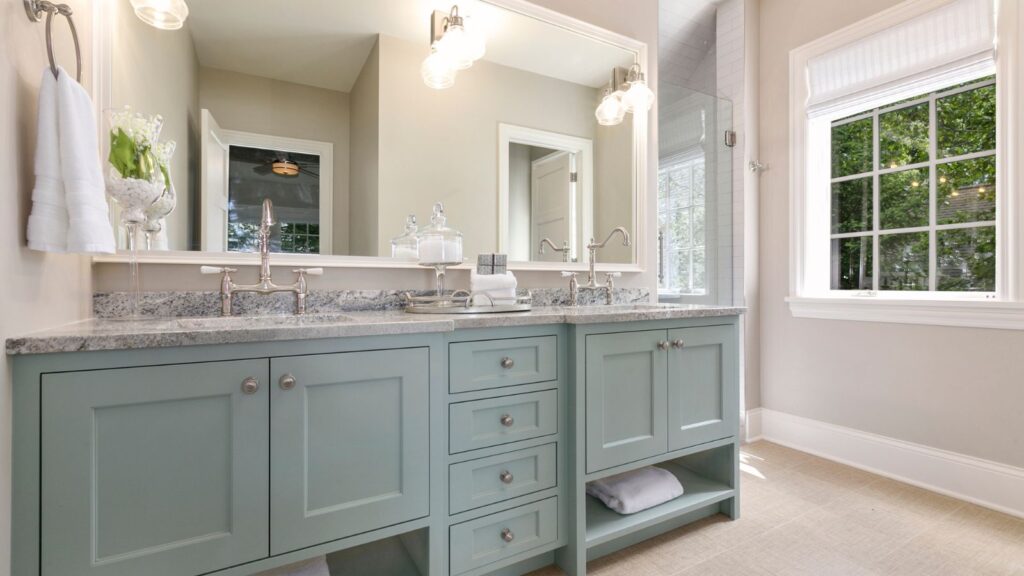Choosing a bathroom wall cabinet isn’t just about style—it’s about finding something that can hold up against humidity, splashes, and daily use. Bathrooms are one of the harshest environments in the home when it comes to moisture, so the material your cabinet is made from really matters. For high-quality renovation solutions that stand the test of time, consider checking out Mode Built, a trusted source for custom bathroom upgrades.
Let’s break down the most common materials used for bathroom wall cabinets, their pros and cons, and which ones will truly go the distance.
1. Solid Wood: Classic but High Maintenance
Solid wood cabinets look stunning and bring a warm, natural element to your bathroom. They’re strong, durable, and can last for years if properly treated.
Pros:
- Timeless look and rich texture.
- Can be sanded and refinished if damaged.
- Very sturdy and solid.
Cons:
- Can warp or swell in high humidity if not sealed properly.
- Typically more expensive than other materials.
- Requires ongoing maintenance to stay in good shape.
Best for: Larger bathrooms with good ventilation or those aiming for a traditional, luxury feel.
2. MDF (Medium Density Fibreboard): Affordable and Versatile
MDF is a popular choice for modern bathroom cabinets. It’s made by compressing wood fibres with resin and wax, giving it a smooth, uniform finish that works well with paint and laminate.
Pros:
- Budget-friendly and widely available.
- Doesn’t have wood grain, so it paints evenly.
- Resists cracking or splitting.
Cons:
- Not water-resistant unless properly sealed.
- Can swell and degrade if exposed to prolonged moisture.
- Doesn’t have the same premium feel as solid wood.
Best for: Cost-conscious renovators or renters who want something easy and stylish without a long-term commitment. Visit Plumbworld to browse bathroom wall cabinet options.
3. Plywood: Strong and Moisture-Resistant
Plywood is a layered wood product that offers a great middle ground between solid wood and MDF. When coated or laminated, it’s very resistant to moisture.

Pros:
- More water-resistant than MDF.
- Very strong and durable.
- Takes paint and veneer well.
Cons:
- More expensive than MDF.
- Edges can be rough if not finished properly.
- Quality varies depending on the grade.
Best for: Busy family bathrooms or anyone looking for longevity without the price tag of solid wood.
4. PVC (Polyvinyl Chloride): Waterproof and Low Maintenance
PVC is a fully synthetic plastic material that’s 100% waterproof. It won’t warp, swell, or rot—making it ideal for high-moisture environments.
Pros:
- Completely waterproof.
- Easy to clean and maintain.
- Resistant to mould and mildew.
Cons:
- Can look and feel “cheap” compared to wood or plywood.
- Limited design options and finishes.
- Less environmentally friendly.
Best for: Wet rooms, small bathrooms with poor ventilation, or households with young kids.
5. Stainless Steel: Industrial and Ultra-Durable
Stainless steel cabinets are becoming more popular, especially in contemporary or industrial-style bathrooms. They’re sleek, sturdy, and pretty much indestructible.
Pros:
- Rust-proof and highly durable.
- Very hygienic and easy to clean.
- Modern, minimalist look.
Cons:
- Can scratch or show fingerprints easily.
- Might feel too “cold” or clinical for some.
- Higher price point.
Best for: High-traffic bathrooms or ultra-modern homes where durability is key.
Which Material Lasts the Longest?
If we’re talking pure longevity and resistance to moisture, stainless steel and PVC take the lead. Both materials are virtually immune to water damage, making them ideal for longevity. However, plywood with a quality laminate or veneer also offers excellent durability with a more traditional look.
The right choice depends on your style, budget, and how much moisture your bathroom typically deals with.
What You Should Not Store in Your Bathroom
When you get a new vanity unit or bathroom cupboard, you want to organise all of your belongings. But, despite the fantastic storage options you now have, you have to be careful what you keep in the bathroom. Let’s take a look at the items you shouldn’t keep here.
Medications
There are a lot of movies where somebody will retrieve their medication from a bathroom cabinet. However, this isn’t the best place to keep them. Know that this is a room in your house that’s exposed to different moisture and heat levels. This can impact medications and their effectiveness. Instead, you need to store them somewhere with stable temperatures and where it’s cool and dry.

Jewellery
If you like to get ready in the bathroom, it’s normal to think about storing jewellery here. This way, it’s on hand when you want to wear something special. However, there are certain materials that don’t react well to moisture. This includes silver and some costume jewellery pieces. Therefore, you could be causing damage and letting your pieces tarnish if you store them in the bathroom.
Perfume
Another item that has to be stored at a stable temperature is perfume. If you leave it in the bathroom, it can break down, which will impact the scent. Over time, it can mean that your perfume doesn’t last long, which can be frustrating. Not only is this a waste of money, but it can mean that you spray it on one day and the scent has changed.
Final Thoughts
When choosing a bathroom wall cabinet, don’t just focus on what looks good today—think about how it’ll hold up in five or ten years. The material you pick plays a huge role in how your cabinet functions, ages, and copes with the everyday splash zone that is the modern bathroom.
If you’re still not sure which way to go, consider your climate, how often your bathroom is used, and whether you’re looking for short-term style or long-term performance. Getting the material right means less hassle, fewer replacements, and a bathroom that stays beautiful for years to come.
